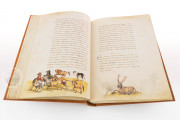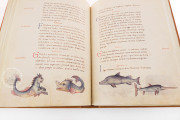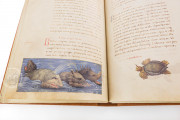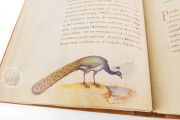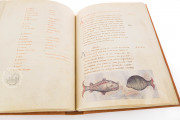The Animal book of Pier Candido is a superb example of Renaissance illumination from Italy. The codex, also known as De omnium animantium naturis [...] was written in the fifteenth century and illuminated at the beginning of the following century with more than 200 exquisitely depicted representations of the animal world, both real and imaginary. The fame of its author and illuminator, respectively Pier Candido and the Master of Ippolita, makes this manuscript an invaluable piece of art.
Written in Latin, the book contains texts and images describing animals, from mammals to birds to insects. Taking its name after the author, a well-known Italian humanist, the manuscript is dated to the year 1460 and was possibly produced in the Urbino scriptorium.
The Master of Ippolita and the Animal Book of Pier Candido
The iconographic apparatus of the Animal Book of Pier Candido is a marvelous example of Renaissance illumination, created by one of its most famous and skilled artist: the Master of Ippolita, who, among many others, was artistically formed in the workshop of the Master of the Vitae Imperatorum.
Taking his name after the fact that he was firstly identified in the codices produced for Ippolita Maria Sforza, daughter of Francesco and Bianca Maria Sforza, he took on the role of cultural representative of the Sforza family, legitimizing their power by the creation of cultural continuity between the new rulers and the Visconti tradition.
"Bianchi Girari" Technique
One of the main features of the Animal book of Pier Candido is the creation of sinuously thin fluctuating images which the Master of Ippolita pairs with an element typical of the humanistic tradition: illumination with the application of white vine-stem (bianchi girari) technique.
This can be noticed in the decorated initials throughout the manuscript, an example is fol. 62v. where the decorated initials bear foliated decorations in green, blue, red, and white (bianco). The depiction of each animal in the bas-de-page shows great attention to detail, even for imaginary animals such as Pegasus (fol. 50v.) or satyr-like figures (fol. 51r.).
The Sforza and Gonzaga Families
As the Latin title of the manuscript suggests, the recipient of the Animal book of Pier Candido was Ludovico III Gonzaga, marquis of Mantua, who ruled the city of Mantua from 1444 to his death in 1478. The commissioner of the work was probably Francesco Sforza, who donated it in the occasion of the papal assembly to ban another Crusade.
Littera Humanistica Rotunda
The script of the Animal book of Pier Candido belongs to the fifteenth-century humanistic script (littera humanistica rotunda). Handsomely simple in its appearance, it was favored in contrast to the Gothic script. In an attempt to restore clarity, the littera humanistica antiqua or rotunda features fewer abbreviations but several ligatures, and descenders do not extend below the baseline (ex. long s).
We have 1 facsimile edition of the manuscript "The Animal Book of Pier Candido": Das Tierbuch des Petrus Candidus facsimile edition, published by Belser Verlag, 1984
Request Info / Price


